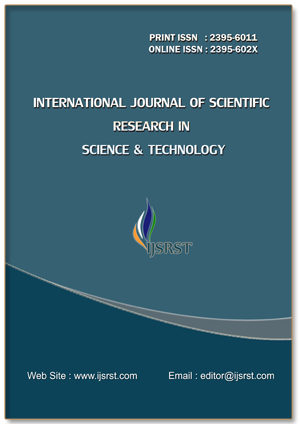Design Data Fusion Model for Distributed Detection of Wireless Sensor Network using Improved Genetic Algorithm
Keywords:
WSN, Distributed Detection, IGA, Data Fusion, MATLAB, EnergyAbstract
The detection of the target node is a big issue in the wireless sensor network environment. the detection of the target node applies the process of distance estimation from the local sensor node to the target sensor node. Therefore, the data fusion methods play a vital role in detecting the target node in a wireless sensor network. The data fusion methods collect the local sensor data and make decisions for the target node. This paper design methods for the detection of the target node. The design model is based on an improved genetic algorithm and data fusion process. The design model reduces the possibility of false detection of the target node and improves energy utilization. However, the utilization of energy is compromised with the maximum distance of the target node with local sensor nodes. The applied model estimates the optimal distance of the target node. The design model simulates in MATLAB environments with standard simulation parameters. The design model compares with two algorithms is called DS and CWN. the analysis suggests that the design model is very efficient in compression with the existing algorithm.
References
- Wang, Jin, Yu Gao, Wei Liu, Arun Kumar Sangaiah, and Hye-Jin Kim. "An intelligent data gathering schema with data fusion supported for mobile sink in wireless sensor networks." International Journal of Distributed Sensor Networks 15, no. 3 (2019): 1550147719839581.
- Papatsimpa, Charikleia, and Jean-Paul Linnartz. "Distributed fusion of sensor data in a constrained wireless network." Sensors 19, no. 5 (2019): 1006.
- Chawla, Apoorva, Rakesh Kumar Singh, Adarsh Patel, Aditya K. Jagannatham, and Lajos Hanzo. "Distributed Detection for Centralized and Decentralized Millimeter Wave Massive MIMO Sensor Networks." IEEE Transactions on Vehicular Technology (2021).
- Wang, Jiayao, Olamide Timothy Tawose, Linhua Jiang, and Dongfang Zhao. "A new data fusion algorithm for wireless sensor networks inspired by hesitant fuzzy entropy." Sensors 19, no. 4 (2019): 784.
- Kumar, D. Praveen, Tarachand Amgoth, and Chandra Sekhara Rao Annavarapu. "Machine learning algorithms for wireless sensor networks: A survey." Information Fusion 49 (2019): 1-25.
- Niayesh Gharaei, Kamalrulnizam Abu Bakar, Siti Zaiton Mohd Hashim, Ali Hosseingholi Pourasl and Suhail Ashfaq Butt “Collaborative Mobile Sink Sojourn Time Optimization Scheme for Cluster-Based Wireless Sensor Networks”, IEEE, 2018, Pp 6669-6676.
- Abhinav Goel, Adarsh Patel, Kyatsandra G. Nagananda and Pramod K. Varshney “Robustness of the Counting Rule for Distributed Detection in Wireless Sensor Networks”, IEEE, 2018, Pp 1191-1195.
- M. Zeeshan, Huma Javed and Sifat Ullah “Discrete R-Contiguous Bit Matching Mechanism Appropriateness for Anomaly Detection in Wireless Sensor Networks”, IJCNIS, 2017, Pp 157163.
- Mohammad Hammoudeh and Robert Newman “Adaptive routing in wireless sensor networks: QoS optimisation for enhanced application performance”, Information Fusion, 2013, Pp 1-13.
- Amitav Mukherjee “Physical-Layer Security in the Internet of Things: Sensing and Communication Confidentiality Under Resource Constraints”, IEEE, 2015, Pp 1747-1761.
- Shiyu Ji, Tingting Chen and Sheng Zhong “Wormhole Attack Detection Algorithms in Wireless Network Coding Systems”, IEEE, 2015, Pp 660-674.
- Chirihane Gherbi, Zibouda Aliouat and Mohamed Benmohammed “An adaptive clustering approach to dynamic load balancing and energy efficiency in wireless sensor networks”, Elisevier, 2016, Pp 647-662.
- Xuelian Cai, Yulong Duan, Ying He, Jin Yang and Changle Li “Bee-Sensor-C: An Energy-Efficient and Scalable Multipath Routing Protocol for Wireless Sensor Networks”, Hindawi Publishing Corporation, 2015, Pp 1-15.
- Irfan Mehmood, Muhammad Sajjad, Waleed Ejaz and Sung Wook Baik “Saliency-directed prioritization of visual data in wireless surveillance networks”, Information Fusion, 2014, Pp 1-16.
- Muhammad Akram and Tae Ho Cho “Energy efficient fuzzy adaptive selection of verification nodes in wireless sensor networks”, Ad Hoc Networks, 2016, Pp 16–25.
- Weiwei Wang, Behzad Kasiri, Jun Cai and Attahiru S. Alfa “Channel assignment schemes for cooperative spectrum sensing in multi-channel cognitive radio networks” Wireless Communications and Mobile Computing, 2015, Pp 1471-1844.
- Georgios B. Giannakis, Qing Ling, Gonzalo Mateos, Ioannis D. Schizas and Hao Zhu “Decentralized Learning for Wireless Communications and Networking”, arXiv, 20155, Pp 1-37.
- Guangjie Han, Yuhui Dong, HuiGuo, Lei Shu and Dapeng Wu “Cross-layer optimized routing in wireless sensor networks with duty cycle and energy harvesting”, Wireless Communications and Mobile Computing, 2015, Pp 1957-1981.
- Nilanjan Biswas, Priyadip Ray and Pramod K. Varshney “Distributed Detection over Channels with Memory”, IEEE, 2015, Pp 1-10.
- Dongjin Park and Taeho Cho “A Fuzzy Rule-based Key Re-Distribution Decision Scheme of Dynamic Filtering for Energy Saving in Wireless Sensor Networks”, I.J. Information Technology and Computer Science, 2017, Pp 1-8.
- Wibowo, Ferry Wahyu, Eko Sediyono, and Hindriyanto Dwi Purnomo. "Detection of Sensor Node-less Area Using A Genetic Algorithm for Wireless Sensor Network." In 2020 3rd International Seminar on Research of Information Technology and Intelligent Systems (ISRITI), pp. 257-261. IEEE, 2020.
Downloads
Published
Issue
Section
License
Copyright (c) IJSRST

This work is licensed under a Creative Commons Attribution 4.0 International License.

